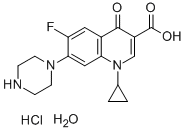Ciprofloxacin , ≥98% , 85721-33-1
Synonym(s):
1-Cyclopropyl-6-fluoro-4-oxo-7-(piperazin-1-yl)-1,4-dihydroquinoline-3-carboxylic acid;Ciprobay
CAS NO.:85721-33-1
Empirical Formula: C17H18FN3O3
Molecular Weight: 331.34
MDL number: MFCD00185755
EINECS: 617-751-0
| Pack Size | Price | Stock | Quantity |
| 1g | RMB25.60 | In Stock |
|
| 5G | RMB48.80 | In Stock |
|
| 25G | RMB128.00 | In Stock |
|
| 100G | RMB416.80 | In Stock |
|
| 500g | RMB1679.20 | In Stock |
|
| others | Enquire |
PRODUCT Properties
| Melting point: | 255-257°C |
| Boiling point: | 581.8±50.0 °C(Predicted) |
| Density | 1.461±0.06 g/cm3(Predicted) |
| storage temp. | Keep in dark place,Inert atmosphere,2-8°C |
| solubility | Soluble in 0.1N HCl at 25mg/ml. Poorly soluble in DMSO |
| pka | pKa 4.04 (Uncertain) |
| form | powder |
| color | White to Almost white |
| Water Solubility | 86mg/L(25 ºC) |
| Merck | 14,2314 |
| BRN | 3568352 |
| CAS DataBase Reference | 85721-33-1(CAS DataBase Reference) |
| EPA Substance Registry System | Ciprofloxacin (85721-33-1) |
Description and Uses
Ciprofloxacin is a quinolone antibacterial related to recently marketed norfloxacin (10), ofloxacin (2), pefloxacin (2) and enoxacin. It has a broad spectrum of activity against gram-positive and gram-negative bacteria, and is useful in the treatment of urinary and upper respiratory tract infections.
Ciprofloxacin is used in the treatment of infections from a wide range of aerobic gram-positive and aerobic gramnegative microorganisms. It has been shown to be effective against inhalational anthrax and reduce the incidence or progression of disease following exposure to aerosolized Bacillus anthracis. It is also used in select respiratory infections, urinary tract infections, typhoid fever, some sexually transmitted diseases, and septicemia. Infectious diarrhea may be caused by organisms found in food or water and transferred by person-to-person contact. This may have a devastating effect, globally, especially in immunocompromised individuals. Ciprofloxacin is effective against those organisms that may contribute to infectious diarrhea, such as Escherichia coli (enterotoxigenic strains), Campylobacter jejuni, and select strains of Shigella; and is utilized when antibacterial therapy is medically indicated. Ciprofloxacin has also been utilized as a secondary agent in the treatment of tuberculosis.
Safety
| Hazard statements | H412 |
| Precautionary statements | P273-P501 |
| Hazard Codes | Xi |
| Risk Statements | 36/37/38 |
| Safety Statements | 26-36-24/25 |
| RIDADR | UN 3077 9 / PGIII |
| WGK Germany | 2 |
| RTECS | VB1993800 |
| HS Code | 29339900 |
| Hazardous Substances Data | 85721-33-1(Hazardous Substances Data) |





